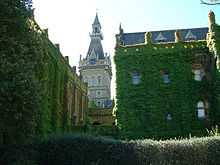University of Melbourne
| The University of Melbourne | |
|---|---|
 | |
| Latin: Universitas Melburnensis | |
| Motto | Postera Crescam Laude (Latin) |
Motto in English | "May I grow in the esteem of future generations" |
| Established | 1853 |
| Type | Public |
| Endowment | AU$1.335 billion[1] |
| Chancellor | Elizabeth Alexander |
| Vice-Chancellor | Glyn Davis |
Academic staff | 3,586[2] |
| Students | 38,281 |
| 3,244 | |
| Location |
Parkville, Victoria, Australia 37°47′47″S 144°57′41″E / 37.7963°S 144.9614°ECoordinates: 37°47′47″S 144°57′41″E / 37.7963°S 144.9614°E |
| Campus | Urban |
| Affiliations | Universitas 21, Go8, APRU, ACU |
| Website | unimelb.edu.au |
 | |
The University of Melbourne (informally Melbourne University or simply Melbourne) is an Australian public university located in Melbourne, Victoria. Founded in 1853, it is Australia's second oldest university[3] and the oldest in Victoria.[3] Times Higher Education ranks Melbourne as 34th in the world,[4] while the QS World University Rankings places Melbourne 33rd in the world.[5] According to QS World University Subject Rankings 2014,[6] the University of Melbourne is ranked 2nd in the world for Education, 8th in Accounting & Finance, and Law, 10th in Psychology, 12th in Medicine, and 15th in Computer Science & IT.
Melbourne's main campus is located in Parkville, an inner suburb north of the Melbourne central business district, with several other campuses located across Victoria. Melbourne is a sandstone university and a member of the Group of Eight, Universitas 21 and the Association of Pacific Rim Universities. Since 1872 various residential colleges have become affiliated with the university. There are 12 colleges located on the main campus and in nearby suburbs offering academic, sporting and cultural programs alongside accommodation for Melbourne students and faculty.
Melbourne comprises 11 separate academic units and is associated with numerous institutes and research centres, including the Walter and Eliza Hall Institute of Medical Research, Florey Institute of Neuroscience and Mental Health, the Melbourne Institute of Applied Economic and Social Research and the Grattan Institute. Amongst Melbourne's 15 graduate schools the Melbourne Business School, the Melbourne Law School and the Melbourne Medical School are particularly well regarded.[7][8][9]
Four Australian prime ministers and five governors-general have graduated from Melbourne. Seven Nobel laureates have been students or faculty, the most of any Australian university.[10]
Arms

The university's coat of arms is a blue shield on which a depiction of "Victory" in white colour holds her laurel wreath over the stars of the Southern Cross. The motto, Postera crescam laude ("Later I shall grow by praise" or, more freely, "We shall grow in the esteem of future generations"), is written on a scroll beneath the shield. The Latin is from a line in Horace's Odes: ego postera crescam laude recens.
History

Melbourne University was established by Hugh Childers, the Auditor-General and Finance Minister, in his first Budget Speech on 4 November 1852, who set aside a sum of £10,000 for the establishment of a university.[11] The university was established by Act of Incorporation on 22 January 1853, with power to confer degrees in arts, medicine, laws and music. The act provided for an annual endowment of £9,000, while a special grant of £20.000 was made for buildings that year.[12] The foundation stone was laid on 3 July 1854, and on the same day the foundation stone for the State Library[13] Classes commenced in 1855 with three professors and sixteen students; of this body of students, only four graduated. The original buildings were officially opened by the Lieutenant Governor of the Colony of Victoria, Sir Charles Hotham, on 3 October 1855. The first chancellor, Redmond Barry (later Sir Redmond), held the position until his death in 1880.
The inauguration of the university was made possible by the wealth resulting from Victoria's gold rush. The institution was designed to be a "civilising influence" at a time of rapid settlement and commercial growth.[14]
In 1881, the admission of women was a seen as victory over the more conservative ruling council.[15]
The university's 150th anniversary was celebrated in 2003.[16]

Governance
Governance of the university is grounded in an act of parliament, the University of Melbourne Act 2009.[17] The peak governing body is the "Council" the key responsibilities of which include appointing the Vice Chancellor and Principal, approving the strategic direction and annual budget, establishing operational policies and procedures and overseeing academic and commercial activities as well as risk management. The chair of the council is the "Chancellor". The "Academic Board" oversees learning, teaching and research activities and provides advice to the council on these matters. The "Committee of Convocation" represents graduates and its members are elected in proportion to the number of graduates in each faculty.[18]
Endowment
In 2008, the university had an endowment of approximately $1.105 billion,[1] the largest of any Australian institution at the time.[19] Whilst the fund had grown rapidly for several years, providing up to $100 million of income per year,[19] it shrank by 22% in 2008 as a result of the ongoing global financial crisis of 2007–2010.[1] However, Australian endowments are relatively small compared with those of the wealthiest US universities.
Academia
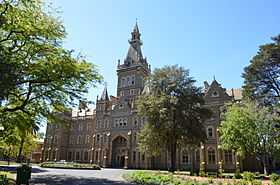
The university has 11 academic units,[20] some of which incorporate a graduate school. The overall attrition and retention rates at the university are the lowest and highest respectively in Australia.[21] The university has one of the highest admission requirements in the country, with the median ATAR of its undergraduates being 94.05 (2009).[22] Furthermore, The university continued to attract outstanding students; for example, 50% of the Premier's VCE Top All-Round High Achievers enrolled at the University of Melbourne.[22]
According to the 2009 Times Higher Education–QS World University Rankings, Melbourne was then the only Australian university to rank in the top 30 in all five core subject areas with three subject areas ranked in the top 20.[22]
Researchers at the University of Melbourne have published a paper, ‘Vocational education's variable links to vocations’, that “considers the roles that tertiary education qualifications, in particular mid-level qualifications, play in assisting their graduates to gain entry to and progression in work and how they may be strengthened".[23]
Research
Melbourne University claims that its research expenditure is second only to that of the Commonwealth Scientific and Industrial Research Organisation (CSIRO).[24] In 2010 the university spent $813 million on research.[2] In the same year the university had the highest numbers of federal government Australian Postgraduate Awards (APA) and International Postgraduate Research Scholarships (IPRS),[25] as well as the largest totals of Research Higher Degree (RHD) student load (3,222 students) and RHD completions (715).[26]
Campus
Residential colleges
Melbourne University has 12 residential colleges in total, seven of which are located in an arc around the cricket oval at the northern edge of the campus, known as College Crescent. The other five are located outside of university grounds.
The residential colleges aim to provide accommodation and holistic education experience to university students.[27]
Most of the University's residential colleges also admit students from RMIT University and Monash University, Parkville campus, with selected colleges also accepting students from the Australian Catholic University and Victoria University.
| Colleges | |||
|---|---|---|---|
| Trinity College 1872–present  | Ormond College 1881–present .jpg) | Janet Clarke Hall 1886–present .jpg) | St Mary's College 1918–present .jpg) |
| Queen's College 1887–present .jpg) | Newman College 1918–present | Medley Hall 1954–present 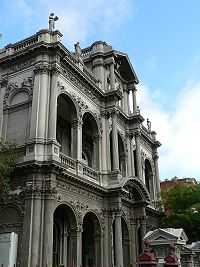 | |
| Whitley College, 1965–present | |||
| Ridley College, 1910–2007 | |||
| University College, 1937–present | |||
| International House, 1957–present | |||
| Graduate House, 1962–present | |||
| St Hilda's College, 1964–present |
Architecture
Several of the earliest campus buildings, such as the Old Quadrangle and Baldwin Spencer buildings, feature period architecture.[28]
The new Wilson Hall[29] replaced the original building[30] which was destroyed by fire.[31]
-

Ian Potter Museum of Art
-
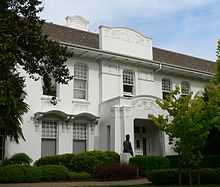
Melba Hall and Conservatorium of Music
-
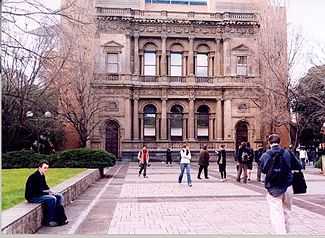
The Old Commerce building combines the relocated facade of a Collins Street bank with a 1930s building
-
The cloisters of the Old Quad.
-

1888 building
-
.jpg)
Newman College Chapel
-
.jpg)
The Chapel of Trinity College
-
Alice Hoy Building
-
South Lawn
-
The Grattan Street main entrance
-
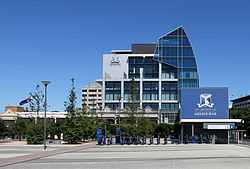
Alan Gilbert Building, University of Melbourne in Carlton
-

Older buildings in the foreground, with newer buildings in the Background
-
Botany Building (1928). Parkville Campus of The University of Melbourne
-

University of Melbourne in autumn
Libraries
The Melbourne University Library has three million visitors performing 42 million loan transactions every year.[32] The general collection comprises over 3.5 million items including books, DVDs, photographic slides, music scores and periodicals as well as rare maps, prints and other published materials.[32] The library also holds over 32,000 e-books, hundreds of databases and 63,000 general and specialist journals in digital form.[32]
The libraries include:[33]
- Baillieu Library (arts and humanities)
- Brownless Biomedical Library
- Eastern Resource Centre (ERC)
- Giblin Eunson Library (business, economics and education)
- Law Library
- Lenton Parr Music, Visual and Performing Arts Library (formerly VCA Library)
- Louise Hanson-Dyer Music Library
- Melbourne School of Land and Environment Library (Burnley, Creswick, Dookie)
- Veterinary Science Library
Other campuses
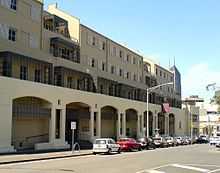
The university has four other campuses in metropolitan Melbourne at Burnley, Southbank, Hawthorn and Werribee.
The Burnley campus is where horticultural courses are taught.[34] Performing arts courses are taught at the Southbank campus. Commerce courses are taught at the Hawthorn campus.[35] Veterinary science is taught at the Werribee campus.
In regional Victoria, the Creswick and Dookie campuses are used for forestry and agriculture courses respectively.[36][37] They previously housed several hundred residential students, but are now largely used for short courses and research. The Shepparton campus is home to the Rural Health Academic Centre for the Faculty of Medicine, Dentistry and Health Sciences.
The university is a part-owner of the Melbourne Business School, based at Parkville campus, which ranked 46th in the 2012 Financial Times global rankings.[38]
Arts and culture
The university is associated with several arts institutions in the wider community. These include:
- The Ian Potter Museum of Art,[39] which houses the university's visual arts collection.
- Thirty-three cultural collections, embodying the history of many of the academic disciplines taught at the university. These include the Grainger Museum Collection of musical cultural artefacts;[40] the Medical History Museum,[41] covering the history of the medical profession in Victoria; and the Harry Brookes Allen Museum of Anatomy and Pathology,[42] which contains more than 8,000 specimens relevant to the teaching of medicine and other health sciences.
"Melbourne Model"
In 2008, the "Melbourne Model" was introduced.
In 2007, Melbourne University aimed to offer 75% of graduate places as HECS (with the remaining 25% being full fee paying).[43]
Professional-entry masters degrees
A number of professional degrees are available only for graduate entry. These degrees are at a masters level according to the Australian Qualification Framework,[44] but are named "masters" or "doctorate" following the practice in North America. The professional degrees are:
- Juris Doctor
- Doctor of Medicine
- Doctor of Dental Surgery
- Doctor of Optometry
- Doctor of Physiotherapy
- Doctor of Veterinary Medicine
- Master of Animal Science
- Master of Architecture
- Master of Applied Linguistics
- Master of Landscape Architecture
- Master of Biotechnology
- Master of Engineering
- Master of Environment
- Master of Education
- Master of Forest Science
- Master of Nursing Science
- Master of Property and Construction
- Master of Public Policy and Management
- Master of Social Work
- Master of Teaching
- Master of Urban Horticulture
- Master of Urban Planning
- Master of Urban Design
- Master of Food Science
Reaction to the "Melbourne Model"
Various groups, including trade[45] and student unions,[46] [47] [48] academics,[49] [50] and some students[51][52] have expressed criticism of the Melbourne Model, citing job and subject cuts, and a risk of "dumbing down" content. A group of students also produced a satirical musical regarding the matter.
VCA merger and controversy
As of May 2009 the university "suspended" the Bachelor of Music Theatre and Puppetry courses at the college and there were fears they may not return under the new curriculum.[53]
A 2005 heads of agreement over the merger of the VCA and the university stated that the management of academic programs at the VCA would ensure that "the VCA continues to exercise high levels of autonomy over the conduct and future development of its academic programs so as to ensure their integrity and quality" and also that the college's identity will be preserved.[54] New dean Sharman Pretty outlined drastic changes under the university's plan for the college in early April 2009.[55] As a result it is now being called into question whether the university have upheld that agreement.
Staff at the college responded to the changes, claiming the university did not value vocational arts training, and voicing fears over the future of quality training at the VCA.[56] Former Victorian arts minister Race Mathews has also weighed in on the debate expressing his hope that, "Melbourne University will not proceed with its proposed changes to the Victorian College of the Arts," and for 'good sense' to prevail.[57]
In 2011, the Victorian State Government allocated $24 million to support arts education at the VCA[58][59] and the faculty was renamed the Faculty of the Victorian College of the Arts and the Melbourne Conservatorium of Music.
Rankings
| University rankings | |
|---|---|
| University of Melbourne | |
| QS World[60] | 33 |
| THE-WUR World[61] | 33 |
| ARWU World[62] | 44 |
| Australian rankings | |
| QS National[63] | 2 |
| THE-WUR National[64] | 1 |
| ARWU National[65] | 1 |
| USNWR National[66] | 1 |
| CWTS Leiden National[67] | 2 |
The following is a summary of Melbourne University rankings, numbers in parentheses indicate ranking within Australia:
| Publications | 2003 | 2004 | 2005 | 2006 | 2007 | 2008 | 2009 | 2010 | 2011 | 2012 | 2013 | 2014 |
|---|---|---|---|---|---|---|---|---|---|---|---|---|
| QS World University Rankings [68] | 22 (2nd) | 19 (1st) | 22 (2nd) | 22 (2nd) | 27 (3rd) | 38 (2nd) | 36 (2nd) | 38 (2nd) | 31 (2nd) | 36 (2nd) | 31 (2nd) | 33 (2nd) |
| Times Higher Education World University Rankings [69] | 22 (2nd) | 19 (1st) | 22 (2nd) | 27 (2nd) | 38 (3rd) | 36 (2nd) | 36 (1st) | 37 (1st) | 28 (1st) | 34 (1st) | 33 (1st) | |
| Shanghai Jiao Tong University Academic Ranking of World Universities[70] | 92 (2nd) | 82 (2nd) | 82 (2nd) | 78 (2nd) | 79 (2nd) | 73 (2nd) | 75 (2nd) | 62 (2nd) | 60 (1st) | 57 (1st) | 54 (1st) | 44 (1st) |
| Higher Education Evaluation and Accreditation Council of Taiwan (HEEACT) [71] | 64 (1st) | 58 (1st) | 51 (1st) | 43 (1st) | 45 (1st) | 35(1st) | 38 (1st) | |||||
| Financial Times MBA rank[72] | 64 (1st) | 72 (2nd) | 63 (1st) | 69 (1st) | 79 (2nd) | 75 (2nd) | 52 | 63 | 53 (2nd) | 46 (2nd) | 62 (2nd) | |
| Economist Intelligence Unit's MBA rank [73] | 84 (2nd) | 26 (1st) | 17 (1st) | 44 | 32 (1st) | 38 (2nd) | 27 (2nd) |
Research produced by the Melbourne Institute in 2006 ranked Australian universities across seven main discipline areas: arts and humanities; business and economics; education; engineering; law; medicine; and science, with Melbourne University as the highest in business, law and medicine by both academic surveys and overall performance.
| Discipline | R1[Note 1] | No.[Note 2] | R2[Note 3] | No. |
|---|---|---|---|---|
| Arts & Humanities | 2 | 38 | 2 | 35 |
| Business & Economics | 1 | 39 | 1 | 34 |
| Education | 1 | 35 | 2 | 32 |
| Engineering | 1 | 28 | 3 | 28 |
| Law | 1 | 29 | 1 | 28 |
| Medicine | 1 | 14 | 1 | 13 |
| Science | 2 | 38 | 3 | 31 |
In 2010 the University Ranking by Academic Performance (URAP),[74] ranked Melbourne Uni 40th globally and highest in Australia.
Notably, in 2013 the University of Melbourne's Medicine course was ranked 9th in the world, the first time an Australian University has been ranked in the top 10 medicine schools [75]
Notable graduates
The University of Melbourne has produced many notable alumni, with graduates having held the offices of Governor-General, Governor of Victoria, Prime Ministers of Australia, Justices of the High, Federal, Family and Victorian Supreme courts, Premiers of Victoria and elected leaders of other states and territories, Nobel Laureates, a First Lady of East Timor, ministers of foreign countries, Lord Mayors, academics, architects, historians, poets, philosophers, politicians, scientists, physicists, authors, industry leaders, defence force personnel, corporate leaders, community leaders, and artists.
Student activities


"Prosh Week"
A celebrated tradition at Melbourne is usually held in mid-August in which teams of students engage in various activities - the winner claiming the "Prosh Week Trophy".[76]
The week was nicknamed "Posh week" due to the number of times students would have to dress up in formal attire. The effects of alcohol caused words to be slurred, and thus "posh" became "prosh".[76]
Sport
The University has participated in various sports in its history and has 39 affiliated clubs. Sport is overseen by Melbourne University Sport.
The Melbourne University Sports Union was the predecessor to the current Melbourne University Sports Association. Since its inception, the aim of the Union and now the Association is to provide a collective voice for all affiliated sporting clubs on the University campus. In 2004, the Melbourne University Sports Association celebrated its centenary.
The Melbourne University Lacrosse Club (MULC) was established in 1883 and is the oldest continually operational lacrosse club in the world.[77]
The Melbourne University Cycling Club (MUCyc) is associated with Cycling Australia and competes regularly at local and national races. In 2008 MUCyc won its seventh consecutive AUG championship (2002–2008).[78][79]
The Melbourne University Tennis Club was one of the original five (5) clubs established for the students and staff of the University, with various tennis competitions and social tennis events held on campus as early as 1882. [80]
Melbourne Accelerator Program (MAP)
Since its inception in 2012, MAP has evolved into a program that hosts a range of public events, workshops and feeder programs to help up-skill and connect entrepreneurs of all stages.[81] The best startups on campus are awarded access to the MAP Startup Accelerator. In 2014, MAP was one of two Australian university accelerators that have been named in a global list of top 25 university incubators produced by University Business Incubator Index.[82]
The first MAP cohort in 2012 includes Bluesky,[83] 121 Cast,[84] VenueMob[85] and New Wave Power Systems. Notably, Bluesky managed to enter the finals of the StarTrack Online Retail Industry Awards 2014[86] for best mobile shopping app against large Australian e-commerce incumbents including The Iconic and 121Cast signed a large content partnership contract with Southern Cross Austereo.[87]
MAP student founders have collectively raised over $5.6 million in funding, created more than 60 jobs and generated over $1.0 million in revenue.[88] They tackle big problems across a range of industries, from medical devices and hardware, to financial technology, web solutions, e-commerce and software.
See also
- List of universities in Australia
- NICTA - national information and communication technology research centre, co-supported by Melbourne University
- University of Melbourne Academic Dress
- Tertiary education in Australia
- Victorian Students' Aid Program
References
- ↑ 1.0 1.1 1.2 "University of Melbourne Investment Report 2013" (PDF). Retrieved 2014-08-13.
- ↑ 2.0 2.1 University of Melbourne: Annual Report 2012
- ↑ 3.0 3.1 "About the University : Future Students". Futurestudents.unimelb.edu.au. Retrieved 2014-01-17.
- ↑ "World University Rankings 2013-2014". Times Higher Education. Retrieved 2014-01-17.
- ↑ "QS World University Rankings 2013". Top Universities. 2013-08-27. Retrieved 2014-01-17.
- ↑ "QS World University Subject Rankings 2014". QS World University Rankings. 2014.
- ↑ "Melbourne University regarded top in the country, but reputation isn't everything". 15 March 2012. Retrieved 18 May 2013.
- ↑ "Australian Universities". Retrieved 18 May 2013.
- ↑ "Melbourne tops discipline based ranking". The Australian. 8 May 2013. Retrieved 19 May 2013.
- ↑ "Prominent Alumni". Retrieved 18 May 2012.
- ↑ "Bools of the Week.". The Courier-Mail (Brisbane, Qld. : 1933 - 1954) (Brisbane, Qld.: National Library of Australia). 27 February 1937. p. 20. Retrieved 8 February 2012.
- ↑ "Melbourne University.". The Argus (Melbourne, Vic. : 1848 - 1956) (Melbourne, Vic.: National Library of Australia). 1 September 1934. p. 6. Retrieved 8 February 2012.
- ↑ "Melbourne Uuniversity.". The Argus (Melbourne, Vic. : 1848 - 1956) (Melbourne, Vic.: National Library of Australia). 1 September 1934. p. 6. Retrieved 9 February 2012.
- ↑ Selleck, 2003
- ↑ Selleck 2003, p 164–165)
- ↑ 150th anniversary University of Melbourne website
- ↑ University of Melbourne Act 2009 (Vic)
- ↑ "Neo-Gothic Buildings (Searching) - Buildings [Walking Melbourne]". Walkingmelbourne.com. Retrieved 2014-01-17.
- ↑ 19.0 19.1 Battered Melbourne Uni slashes 220 jobs, The Age, 29 July 2009
- ↑ "Faculties and Graduate Schools". Unimelb.edu.au. Retrieved 2014-01-17.
- ↑ Does this model have legs?, The Age, 15 August 2009
- ↑ 22.0 22.1 22.2 "University of Melbourne at a glance" (PDF). University of Melbourne. Retrieved 2014-01-17.
- ↑ "University of Melbourne Annual Report 2010" (WEB). Retrieved 2015-04-28.
- ↑ "2013 Graduate Prospectus". Bpointelligence.com. Retrieved 2014-01-17.
- ↑ "International Postgraduate Research Scholarships (IPRS)". Innovation.gov.au. Retrieved 2014-01-17.
- ↑ "University of Melbourne Annual Report 2010" (PDF). Retrieved 2014-01-17.
- ↑ "Why Live in a College? — Residential Colleges of the University of Melbourne". Colleges.unimelb.edu.au. Retrieved 2014-01-17.
- ↑ "Melbourne University website". Retrieved 2014-01-17.
- ↑ "Melbourne University website". Retrieved 2014-01-17.
- ↑ "Melbourne University website". Retrieved 2014-01-17.
- ↑ "Melbourne University website". Retrieved 2014-01-17.
- ↑ 32.0 32.1 32.2 About Us - Library, University of Melbourne website
- ↑ "University of Melbourne Libraries". Library.unimelb.edu.au. Retrieved 2014-01-17.
- ↑ "Melbourne School of Land & Environment. Burnley Campus". Retrieved 22 January 2014.
- ↑ "Our History". Commercial.unimelb.edu.au. Retrieved 2014-01-17.
- ↑ "Melbourne School of Land & Environment. Creswick Campus". Retrieved 22 January 2014.
- ↑ "Dookie". Dookie.unimelb.edu.au. Retrieved 2014-01-17.
- ↑ "Global MBA rankings 2006". Rankings.ft.com. Retrieved 2014-01-17.
- ↑ "Ian Potter Museum of Art". Art-museum.unimelb.edu.au. Retrieved 2014-01-17.
- ↑ "Grainger Museum". Lib.unimelb.edu.au. Retrieved 2014-01-17.
- ↑ "Medical History Museum". Retrieved 2014-01-17.
- ↑ Harry Brookes Allen Museum of Anatomy and Pathology
- ↑ A matter of degrees, The Age, 14 April 2007
- ↑ Australian Qualifications Framework. First Edition July 2012. [Cited 2 July 2012] URL: http://www.aqf.edu.au/Portals/0/Documents/Handbook/AustQuals%20FrmwrkFirstEditionJuly2011_FINAL.pdf.
- ↑ "NTEU condemns University oF Melbourne's consultation sham over arts renewal strategy" National Tertiary Education Union, 10 July 2007. Accessed 3 May 2008
- ↑ Cuts take toll on 'overworked' Melbourne Uni staff The Age, 11 April 2008. Accessed 3 May 2008
- ↑ What do budgets, Burnley and the housing crisis have in common? President's Ponderings, 25 August 2008. Accessed 20 October 2008
- ↑ Vice Chancellor Lies About Introduction of Melbourne Model at VCA VCA Student Union, 29 April 2008. Accessed 3 May 2008
- ↑ 'Dreamlarge' a nightmare for the Arts Faculty Advocate, Volume 14, Number 2, July 2007. Accessed 26 October 2008
- ↑ "The Melbourne Model: The jury is still out", Advocate, Volume 14, Number 2, July 2007. Accessed 26 October 2008
- ↑ "Why the Melbourne Model is failing students", Eureka Street, 12 December 2008. Accessed 14 December 2008
- ↑ "Express yourself, but steer clear of politics", The Age, 7 June 2008. Accessed 8 August 2008
- ↑ 21 May 2009, Accessed 19 July 2009
- ↑ 5.5.R1 – The Faculty of The Victorian College of The Arts. Accessed 19 July 2009
- ↑ Pretty well rehearsed in reshaping the arts. 12 April 2009. Accessed 19 July 2009
- ↑ Arts college teachers up in arms. 16 July 2009, Accessed 19 July 2009
- ↑ 28 May 2009. Accessed 19 July 2009
- ↑ "Exciting new era for VCA as Premier announces details of $24 million funding package". Retrieved 23 January 2014.
- ↑ "VCA future bright thanks to $24million budget allocation". Retrieved 23 January 2014.
- ↑ "QS World University Rankings 2014". Quacquarelli Symonds Limited.
- ↑ "Times Higher Education World University Rankings 2014-2015". TSL Education Limited.
- ↑ "Academic Ranking of World Universities 2014". Shanghai Ranking Consultancy.
- ↑ "QS World University Rankings 2014". Quacquarelli Symonds Limited.
- ↑ "THE 2014-2015 Top 400 Universities in Oceania". TSL Education Limited.
- ↑ "ARWU 2014 Top 500 Universities in Australia". Shanghai Ranking Consultancy.
- ↑ "U.S. News and World Report Best Global Universities in Australia/New Zealand". U.S. News and World Report.
- ↑ "CWTS Leiden Ranking 2014". Centre for Science and Technology Studies, Leiden University.
- ↑ "QS World University Rankings - 2013". Retrieved 22 January 2014.
- ↑ "Times Higher Education World University Rankings". The Times Higher Education World University Rankings 2014-2015. Retrieved 2 October 2014.
- ↑ "Academic Ranking of World Universities 2013". Retrieved 2 October 2014.
- ↑ "National Taiwan University Ranking". Retrieved 22 January 2014.
- ↑ "Melboure Business School's MBA rank with the Financial Times". Rankings.ft.com. Retrieved 2014-01-17.
- ↑ "The Economist MBA ranking". Retrieved 22 January 2014.
- ↑ "URAP - University Ranking by Academic Performance".
- ↑ "QS World University Rankings for Medicine 2013".
- ↑ 76.0 76.1 "What is Prosh Week?", Farrago, Vol. 82, No. 5, August 2007.
- ↑ "Melbourne University Lacrosse Club". Mulax.org. Retrieved 2014-01-17.
- ↑ Warnecke R., "Team Melbourne wins record haul at Uni Games", University sports news and events
- ↑ Warnecke R,m "Gold Rush At Uni Games", University of Melbourne Voice, 10 November 2008
- ↑
- ↑ "Melbourne Accelerator Program". Melbourne University Engineering Department. Retrieved 2014-11-21.
- ↑ "Two Australian university accelerators named in global top 25 list". Startup Smart Australia. Retrieved 2014-11-21.
- ↑ "Bluesky Homepage". Bluesky. Retrieved 2014-11-21.
- ↑ "121Cast Homepage". 121Cast. Retrieved 2014-11-21.
- ↑ "VenueMob Homepage". Venuemob. Retrieved 2014-11-21.
- ↑ "Meet the Finalists of the StarTrack Online Retail Industry Awards 2014". PowerRetail. Retrieved 2014-11-21.
- ↑ "Audio app Omny scores content partnership with Southern Cross Austereo". Startup Smart Australia. Retrieved 2014-11-21.
- ↑ "About the Melbourne Accelerator Program". Melbourne University Engineering Department. Retrieved 2014-11-21.
Books
- Macintyre, S. & Selleck, R.J.W. (2003). A short history of the University of Melbourne. Melbourne: Melbourne University Press. ISBN 0-522-85058-8.
- Selleck, R.J.W. (2003). The Shop: The University of Melbourne, 1850–1939. Melbourne: University of Melbourne Press. 930pp
- Poynter, John & Rasmussen, Carolyn (1996). A Place Apart - The University of Melbourne: Decades of Challenge. Melbourne: Melbourne University Press. ISBN 0-522-84584-3.
- Cain J II and J Hewitt. (2004). Off Course: From Public Place to Marketplace at Melbourne University. Melbourne: Scribe. review
Newspaper
- McPhee, P. 2005. "From the Acting Vice-Chancellor." Uni News. The University of Melbourne. 03/10/05, p. 3.
External links
| Wikimedia Commons has media related to University of Melbourne. |
| ||||||||||||||||||||||
